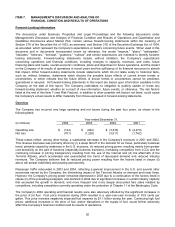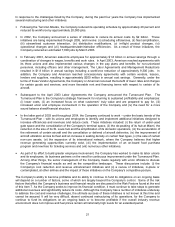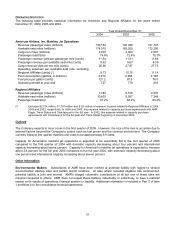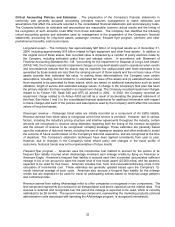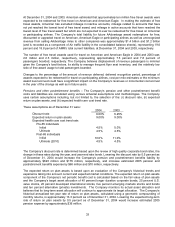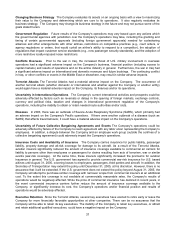American Airlines 2004 Annual Report Download - page 31
Download and view the complete annual report
Please find page 31 of the 2004 American Airlines annual report below. You can navigate through the pages in the report by either clicking on the pages listed below, or by using the keyword search tool below to find specific information within the annual report.
28
In 2003, American had capacity purchase agreements with Chautauqua and Trans States for the full year. In
2002, American had a capacity purchase agreement with Chautauqua for the full year and a capacity purchase
agreement with Trans States beginning in November 2002.
Regional Affiliates’ passenger revenues increased $88 million, or 6.1 percent, to $1.5 billion as a result of
increased capacity and load factors. Regional Affiliates’ traffic increased 20.5 percent, or 940 million RPMs, to 5.5
billion RPMs, while capacity increased 18.6 percent, or 1.3 billion ASMs, to 8.6 billion ASMs. This is somewhat
offset by the elimination, in 2003, of a fee, paid to AMR Eagle by American, for passengers connecting to
American flights.
OPERATING EXPENSES
2004 Compared to 2003 The Company’s total operating expenses increased 2.8 percent, or $505 million, to
$18.8 billion in 2004 compared to 2003. American’s mainline operating expenses per ASM in 2004 decreased 4.1
percent compared to 2003 to 9.73 cents. This decrease in operating expenses per ASM is due primarily to the
American’s cost savings initiatives and occurred despite the benefit in 2003 of the receipt of a grant from the U.S.
government and a 38.5 percent increase in American’s price per gallon of fuel (net of the impact of fuel hedging) in
2004 relative to 2003.
(in millions)
Operating Expenses
Year ended
December 31,
2004
Change
from 2003
Percentage
Change
Wages, salaries and benefits $ 6,719 $ (545) (7.5)% (a)
Aircraft fuel 3,969 1,197 43.2 (b)
Depreciation and amortization 1,292 (85) (6.2)
Other rentals and landing fees 1,187 14 1.2
Commissions, booking fees and credit
card expense 1,107 44 4.1
Maintenance, materials and repairs 971 111 12.9 (c)
Aircraft rentals 609 (78) (11.4) (d)
Food service 558 (53) (8.7)
Other operating expenses 2,366 (62) (2.6)
Special charges 11 (396) (97.3) (e)
U.S. government grant - 358 NM (f)
Total operating expenses $ 18,789 $ 505 2.8%
(a) Wages, salaries and benefits decreased due to lower wage rates and reduced headcount primarily as
a result of the Labor Agreements and Management Reductions, discussed in the Company’s 2003
Form 10-K, which became effective in the second quarter of 2003. This decrease was offset to some
degree by increased headcount related to capacity increases.
(b) Aircraft fuel expense increased due to a 38.7 percent increase in the Company’s price per gallon of
fuel (net of the impact of fuel hedging) and a 3.3 percent increase in the Company’s fuel consumption.
(c) Maintenance, materials and repairs increased primarily due to increased aircraft utilization, the benefit
from retiring aircraft subsiding and increases in contractual rates in certain flight hour agreements for
outsourced aircraft engine maintenance.
(d) Aircraft rentals decreased primarily due to the removal of leased aircraft from the fleet in the second
half of 2003 as part of the Company’s restructuring initiatives and concessionary agreements with
certain lessors, which reduced future lease payment amounts and resulted in the conversion of 30
operating leases to capital leases in the second quarter of 2003.
(e) Special charges for 2004 included (i) the reversal of reserves previously established for aircraft return
costs of $20 million, facility exit costs of $21 million and employee severance of $11 million, (ii) $21
million in aircraft charges and (iii) $42 million in employee charges. Special charges for 2003 are
described on the following page. See a further discussion of Special charges in Note 2 to the
consolidated financial statements.
(f) U.S. government grant for 2003 reflects the reimbursement of security service fees from the U.S.
government under the Appropriations Act.




